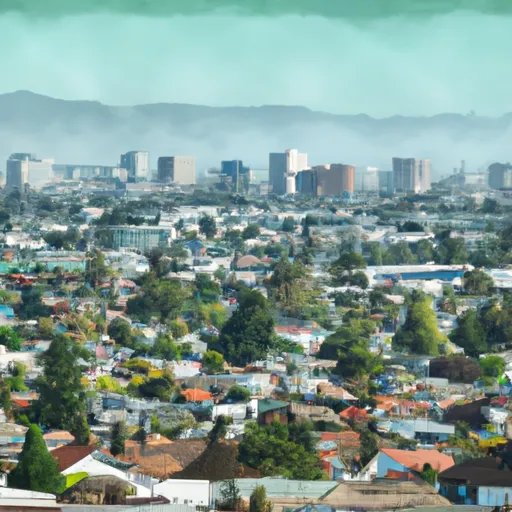-
 Snoflo Premium
Snoflo Premium
Get unlimited access to all our content
With no Ad interruptions! - Start Your Free Trial Login with existing account
San-Fernando
Eden Index
Climate
9.2
•
Recreation
2.9
•
Community
2.6
•
Safeguard
5.3/10

San Fernando, California is a vibrant city located in the San Fernando Valley, north of Los Angeles. The city experiences a Mediterranean climate characterized by hot, dry summers and mild, wet winters. Summers are typically sunny with temperatures reaching highs in the mid-90s°F (mid-30s°C), while winter temperatures average in the mid-60s°F (around 18°C). The region is known for its low humidity and minimal rainfall, with most precipitation occurring between November and April.
Hydrologically, San Fernando is primarily influenced by the Pacoima Wash and the Tujunga Wash, which are important constituents of the city's water system. These waterways play a crucial role in managing stormwater runoff and replenishing local groundwater supplies.
San Fernando offers a variety of outdoor recreational opportunities for residents and visitors. The nearby Angeles National Forest is a haven for hikers, offering numerous scenic trails with breathtaking views. Hansen Dam Recreation Area is another popular destination, providing opportunities for swimming, boating, fishing, and picnicking. For golf enthusiasts, the Hansen Dam Golf Course offers a beautiful, well-maintained 18-hole course. Overall, San Fernando's climate, hydrology, and outdoor recreational offerings make it an attractive destination for nature lovers and adventure seekers.
What is the Eden Index?
The Snoflo Eden Index serves as a comprehensive rating system for regions, evaluating their desirability through a holistic assessment of climate health, outdoor recreation opportunities, and natural disaster risk, acknowledging the profound impact of these factors on livability and well-being.
Climate Health Indicator (CHI): 9.2
San-Fernando receives approximately
427mm of rain per year,
with humidity levels near 72%
and air temperatures averaging around
19°C.
San-Fernando has a plant hardyness factor of
10, meaning
plants and agriculture in this region tend to thrive here all year round.
By considering the ideal temperature range, reliable water supplies, clean air, and stable seasonal rain or snowpacks, the Climate Health Indicator (CHI) underscores the significance of a healthy climate as the foundation for quality living.
A healthy climate is paramount for ensuring a high quality of life and livability in a region, fostering both physical well-being and environmental harmony. This can be characterized by ideal temperatures, reliable access to water supplies, clean air, and consistent seasonal rain or snowpacks.
Weather Forecast
Streamflow Conditions
Ventura-San Gabriel Coastal
Area Rivers
Ventura-San Gabriel Coastal
Snowpack Depths
Ventura-San Gabriel Coastal
Reservoir Storage Capacity
Ventura-San Gabriel Coastal
Groundwater Levels
Recreational Opportunity Index (ROI): 2.9
The Recreational Opportunity Index (ROI) recognizes the value of outdoor recreational options, such as parks, hiking trails, camping sites, and fishing spots, while acknowledging that climate plays a pivotal role in ensuring the comfort and consistency of these experiences.
Access to outdoor recreational opportunities, encompassing activities such as parks, hiking, camping, and fishing, is crucial for overall well-being, and the climate plays a pivotal role in enabling and enhancing these experiences, ensuring that individuals can engage in nature-based activities comfortably and consistently.
Camping Areas
| Campground | Campsites | Reservations | Toilets | Showers | Elevation |
|---|---|---|---|---|---|
| Upper Shake | 17 | 4,412 ft | |||
| Dockweiler Beach RV | 117 | 45 ft | |||
| Castaic Lake | 60 | 1,184 ft | |||
| Streamside | 9 | 2,364 ft | |||
| Spunky | 10 | 3,191 ft | |||
| Bear | 7 | 5,420 ft |
Catastrophe Safeguard Index (CSI):
The Catastrophe Safeguard Index (CSI) recognizes that natural disaster risk, encompassing floods, fires, hurricanes, and tornadoes, can drastically affect safety and the overall appeal of an area.
The level of natural disaster risk in a region significantly affects safety and the overall livability, with climate change amplifying these risks by potentially increasing the frequency and intensity of events like floods, fires, hurricanes, and tornadoes, thereby posing substantial challenges to community resilience and well-being.
Community Resilience Indicator (CRI): 2.6
The Community Resilience Indicator (CRI) recognizes that education, healthcare, and socioeconomics are crucial to the well-being of a region. The CRI acknowledges the profound impact of these elements on residents' overall quality of life. By evaluating educational resources, healthcare accessibility, and economic inclusivity, the index captures the essential aspects that contribute to a thriving community, fostering resident satisfaction, equity, and social cohesion.

